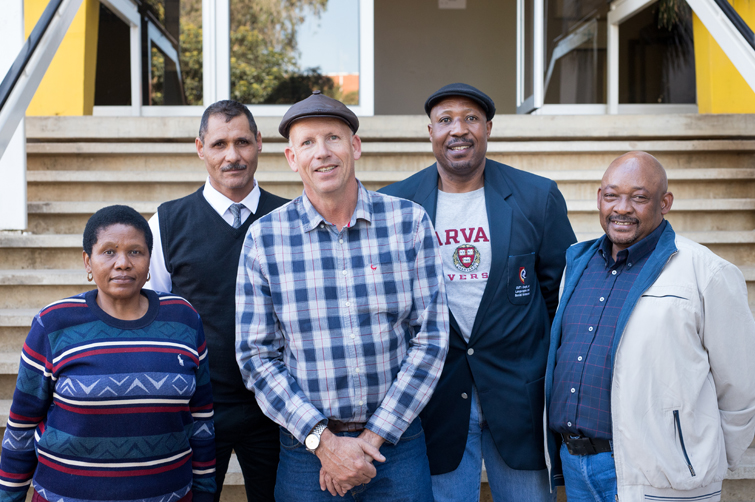Latest News Archive
Please select Category, Year, and then Month to display items
13 January 2020
|
Story Eugene Seegers
|
Photo Anja Aucamp
 Spearheading the digital expansion of the conversational Sesotho course is IDEAS Lab Director, Johann Möller (middle). With him are from the left: Prof Pule Phindane, CUT; Dr Brenton Fredericks, CUT; Bahedile Letlala, UFS Department of African Languages; and Dr Elias Malete, UFS Department of African Languages.
Spearheading the digital expansion of the conversational Sesotho course is IDEAS Lab Director, Johann Möller (middle). With him are from the left: Prof Pule Phindane, CUT; Dr Brenton Fredericks, CUT; Bahedile Letlala, UFS Department of African Languages; and Dr Elias Malete, UFS Department of African Languages.
For many years now, the UFS has been offering a one-year course in conversational Sesotho for staff members; this can then be followed up with the one-year course in advanced conversational Sesotho. The conversational Sesotho for students in the Faculty of Education was introduced in 2018 at the UFS.
The Central University of Technology (CUT) needed a conversational course for its first-year students and approached the Department of African Languages for the development of such a course. Living as we do in a multilingual country; this additional language skill opens doors and often hearts as well.
Using instructional design principles
However, the need was identified by both CUT and UFS to present this crucial information in a way that would be more appealing to digital natives as well as to those less familiar with technology. The Department of African Languages on the UFS Bloemfontein Campus, together with relevant departments from the CUT, approached the IDEAS Lab located on the UFS South Campus, since they already have a reputation for being a specialist on broadcasting and repackaging curricular content for digital presentations. The IDEAS Lab provided technical advice and built the multimedia programme, which will help the user to hear and practice phrases in Sesotho, using instructional design principles. The course will be available to both staff and students belonging to the two universities.
Room for growth
Johann Möller, Director of the IDEAS Lab, says this pilot programme will give both institutions the opportunity to test the use of multimedia for language acquisition. He adds, “Language is extremely complex, and we would like to expand this learning aid in the future.” In fact, the original design has room for growth built into it.
To keep things simple for the user and the building team, it was decided to start out with only four potential everyday scenarios where a staff member would like to speak Sesotho: Firstly, how to greet other persons from different genders; secondly, potential scenarios one might encounter in the university environment itself; thirdly, how to deal with situations at a hospital; and finally, how to use one’s language skills at a filling station.
Pronunciation is key
Each scenario contains three to four conversations that the learner can revise, along with images and audio that illustrate the situation and assist with correct pronunciation. The system does not allow the user to progress unless they have listened to the pronunciations of the sample sentences or phrases.
Further reading material and vocabulary lists are also provided, with the result that people who are using the programme can learn at their own pace. The authoring software Articulate Storyline was used to build the individual scenarios and each conversation or lesson within it. The lessons are also not dependent on an internet connection; they can be downloaded onto a flash memory drive and used offline.
UFS becomes the first university in Africa to sign a memorandum of understanding with the United Nations University
2009-12-01
 |
During the signing of the memorandum of agreement between DiMTEC and the United Nations University in Bonn, Germany were, from the left, seated: Prof. Konrad Osterwalder, Under-Secretary-General of the United Nations and Rector of the United Nations University; and Prof. Herman van Schalkwyk, Dean of the Faculty of Natural and Agricultural Sciences at the UFS; back: Prof. Dusan Sakulski, Academic Officer, UNU Cooperative Unit for South Africa; and Mr Andries Jordaan, Director of DiMTEC at the UFS.
Photo: Supplied
|
The University of the Free State (UFS) has become the first university in Africa to sign a memorandum of understanding with the United Nations University. The memorandum of understanding was negotiated by Mr Andries Jordaan, Director of the UFS's Disaster Management Training and Education Centre for Africa (DiMTEC).
Mr Jordaan negotiated with the United Nations University Institute for Environment and Human Security (UNU-EHS) to foster a relationship and combine their pool of resources for training in different aspects of Disaster Management. A triangular agreement between DiMTEC, UNU-EHS and the University of Novi Sad in Serbia will be established in three phases. The first phase is the signing of a memorandum of understanding between DiMTEC and UNU-EHS. This phase was completed in September 2009, when Prof. Konrad Osterwalder, Under-Secretary-General of the United Nations and Rector of the United Nations University, and Prof. Herman van Schalkwyk, Dean of the Faculty of Natural and Agricultural Sciences at the UFS signed the memorandum in Bonn, Germany. The second phase is a memorandum of understanding between UNU-EHS and the University of Novi Sad.
The memorandum of understanding entails among others joint projects between DiMTEC and the UNU-EHS, research for specific projects, exchange of lecturers and that the UNU will assist DiMTEC with external evaluation. As a result of this memorandum, the two universities have already combined their pool of resources by presenting a vulnerability short course and a visitation to the Republic of the Congo. |